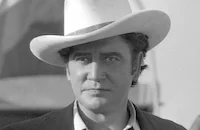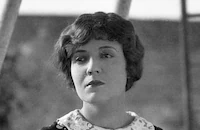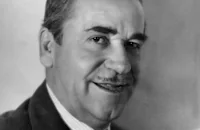The Vanishing American

Brief Synopsis
Cast & Crew
George B. Seitz
Richard Dix
Lois Wilson
Noah Beery
Malcolm Mcgregor
Nocki
Film Details
Technical Specs

Synopsis
After a prologue unfolding the history of the Navajo in the West, the story is told of Nophaie, a strong, righteous Indian, who thrashes Booker, an evil Indian agent, for attempting to force his attentions on Marion Warner, the white schoolteacher with whom Nophaie is in love. Nophaie flees into the hills in order to escape Booker's vengeance and returns only to persuade his people to give over their horses to Earl Ramsdale, an Army procurement agent needing horses for the war. Nophaie enlists and saves Ramsdale's life during the fighting, learning then that Ramsdale is in love with Marion. After the war Nophaie returns to his people and finds that they are living in squalor. The Indians go on the warpath, and Nophaie rides to warn the whites. Nophaie and Booker die in the fighting, and Nophaie's only comfort is to die in the arms of Marion.

Director
George B. Seitz
Cast

Richard Dix

Lois Wilson

Noah Beery

Malcolm Mcgregor
Nocki
Shannon Day
Charles Crockett
Bert Woodruff
Bernard Siegel
Guy Oliver
Joe Ryan
Charles Stevens
Bruce Gordon
Richard Howard
John Webb Dillon
Crew

Film Details
Technical Specs

Articles
The Vanishing American (1925)
According to biographer Frank Gruber, Grey modeled the hero Nophaie in part after the Native American athlete Jim Thorpe. Kidnapped as a young boy and raised and educated among whites, Nophaie experiences an identity crisis which is lacking in the film. Grey further challenged social mores of the period by depicting a romantic relationship between Nophaie, the hero, and the white missionary Marion Warner. In that regard, the serialized version ends with Nophaie surviving and the two remaining as a couple. In contrast, Nophaie dies both in the film and the 1925 edition of the novel published by Harper. Still, Gruber considers The Vanishing American "one of Zane Grey's very best novels." Interestingly, in the 1955 adaptation directed by Joe Kane for Republic Pictures, the hero (renamed "Blandy") survives his gunshot wound and stays with Marion, making its ending closer to the original serialized version.
The Vanishing American was in fact one of several Zane Grey adaptations produced by Paramount and adapted by Lucien Hubbard with Grey's approval. If it seems odd that a large scale production like this could be completed the same year as the source novel was published, planning for the film in fact began a couple of years earlier, just after the serialized version was published in Ladies' Home Journal. In a September 1925 interview for The New York Times, Lasky claimed that the idea for adapting this particular story arose during a trip to Navaho Mountain and Rainbow Bridge in Arizona, at the invitation of Hubbard and Grey. Lasky also claimed that he had Richard Dix in mind for the lead role from the very start.
Initially William K. Howard was slated to direct the film. No stranger to Zane Grey's work, he had adapted The Border Legion (1924), Code of the West (1925) and The Light of the Western Stars (1925) and The Thundering Herd (1925) within the space of two years. Describing The Vanishing American as "one of the biggest assignments in the history of Famous Players-Lasky Corporation," Lasky cited Howard's success with The Thundering Herd and Howard's "real genius for spectacles." However, Lasky ended up assigning the film to the veteran director George B. Seitz instead.
The filming of The Vanishing American began in June 1925 and finished that September. Most of it was filmed within the vast Navaho Nation reservation; locations included Monument Valley, Rainbow Bridge and Tsegi (or Sagi) Canyon. Newspaper publicity at the time cited 10,000 Native American extras, in addition to the 500 member cast and crew brought from Hollywood. Hay for the horses had to be shipped by train to Flagstaff--165 miles from the main shooting location--then driven the rest of the way by truck. For the cliff dwellings depicted in the film, cement, lumber and other construction materials had to be carried by pack mule into Tsegi Canyon.
Beyond the basic logistics of shooting in such a remote location, the crew encountered a wide range of difficulties. Lasky recalled that the crew's trucks frequently blew tires due to rough road conditions. After all-too-frequent sandstorms, the crew had to take apart and clean the six film cameras used during the production. Furthermore, shooting halted almost daily due to summer rainstorms, even if these storms lasted only briefly. At the same time, Richard Dix, writing a letter to reporter Grace Kingsley, insisted that the production was enjoyable in an adventurous way: "We're really having a great time, even if we are in the most isolated spot in the United States. [...] We have lots of fun, eat breakfast at 5 in the morning, gallop over the hot sands all day, return at night to eat an 8:30 or 9 o'clock dinner, and then just squander half an hour before rolling into bed and sleeping like the dead until the siren wakes us at 4:30 a.m."
The Vanishing American opened in New York on October 15, 1925 to mostly positive reviews. Mordaunt Hall of The New York Times had some reservations about the performances, but he admired the film's "matchless photography" and the "great artistry" of the cliff dwelling and World War I battle sequences. He also praised Hugo Riesenfeld's score, which the composer himself conducted for the film's premiere at the Criterion Theatre. The Variety reviewer's response was more mixed. He complained that the first half was "draggy" and made a condescending remark about the film's "tear [sic] effect on the women." At the same time, he admitted that "Dix gives a corking performance" and that "Louis Wilson was a sincere and altogether charming heroine." Although today The Vanishing American is remembered mainly for its early, sympathetic portrayal of the plight of Native Americans, it also serves as a vivid reminder of how during the Twenties, Westerns were not just low-budget genre quickies, but in many cases were major productions behind which the studios invested considerable talent and resources.
Producers: Adolph Zukor and Jesse Lasky
Director George B. Seitz
Screenplay: Ethel Doherty and Lucien Hubbard, adapted from the novel The Vanishing American (1925) by Zane Grey
Photography: C. Edgar Schoenbaum and Harry Perry
Technical Advisor: Louisa Wetherill
Cast: Richard Dix (Nophaie), Lois Wilson (Marion Warner), Noah Beery (Booker), Malcolm McGregor (Earl Ramsdale), Nocki (Indian boy), Shannon Day (Gekin Yashi), Charles Crockett (Amos Halliday), Bert Woodruff (Bart Wilson), Bernard Siegel (Do Etin), Guy Oliver (Kit Carson), Joe Ryan (Jay Lord), Charles Stevens (Shoie), Bruce Gordon (Rhur), Richard Howard (Glendon), John Webb Dillon (Naylor).
BW-109m.
by James Steffen
Sources:
"Howard Given Real Chance in Zane Grey Play" Los Angeles Times, May 24, 1925, p.34.
"Producing Indian Film Was a Stupendous Task." New York Times, September 20, 1925, p.X5.
"Shows Early Horses." Los Angeles Times, August 2, 1925, p.19.
"The Vanishing American." Variety, October 21, 1925.
"To Play Indian Role in Epic of Red Man" Los Angeles Times, June 2, 1925, p.A15.
Grey, Zane. The Vanishing American. New York: Harper and Brothers, 1925.
Gruber, Frank. Zane Grey. New York and Cleveland: World Publishing Company, 1970.
Hall, Mordaunt. "The American Indian." [Review of The Vanishing American] New York Times, October 16, 1925, p.18.
Kingsley, Grace. "Richard Writes." Los Angeles Times, July 18, 1925, p.7.
Pauly, Thomas H. Zane Grey: His Life, His Adventures, His Women. Urbana and Chicago: University of Illinois Press, 2005.

The Vanishing American (1925)
Quotes
Trivia
The rumor about the herd of 14 bison being brought to Catalina Island for the filming of this movie was debunked by the curator of the Catalina Museum on the KPBS show ''California's Gold''.
The legend that 'John Ford' "discovered" Monument Valley (or 'John Wayne' did), or Harry Goulding (the trading post owner there) introduced Ford to this unique location in 1938 for Stagecoach (1939), is disproved by the fact that this movie was filmed there in 1925.
Notes
A 1955 Republic production, directed by Joe Kane and starring Scott Brady and Audrey Totter, was also based on the Zane Grey novel The Vanishing American. According to a modern source, the 1925 film was also based on portions of other Grey stories as Grey had not yet completed his novel when work on the film began.














